FAO forecasts slight increase in area under wheat cultivation in Iran

TEHRAN- United Nations’ Food and Agriculture Organization (FAO) has estimated that the area under wheat cultivation in Iran will increase slightly in 2020, reliefweb.int published on Tuesday.
The planted area is estimated at about 6 million hectares, a slight increase from the 5.85 million hectares planted in the previous year, FAO said in a report.
Harvesting of the 2020 winter season wheat, the principal cereal crop, started in June and was completed in mid‑July.
About one‑third of the wheat fields are irrigated and the rest is rainfed, making production highly susceptible to rainfall variation. Although early season dryness prevailed in parts of the country up to December 2019, abundant rain amounts since January replenished soil moisture.
At the end of April, seasonal flooding due to heavy rainfall affected 18 provinces, particularly in central and eastern parts of the country. Localized damages to crops (especially wheat, garlic and orchards) and significant damages to agricultural infrastructure were reported in Kerman, Khorasan, Qom, Khorasan Razavi, Yazd, Urmia and Golestan provinces. Floods damaged also about 10,000 km of roads. At the end of May, more flooding affected the central and northern provinces.
Although desert locust is a common pest in the country, breeding conditions in 2020 were particularly favorable due to abundant rains in the country. Seven provinces (Sistan-Baluchistan, Hormozgan, Bushehr, Fars, Khuzestan, Kerman and South Khorasan) in the southern part of the country, stretching from the eastern Islamic Republic of Iran on the border with Pakistan to the southwestern border with Iraq, were affected. As of June 2020, seasonal infestations were declining due to control operations and migration to Indo‑Pakistan summer breeding areas. More than 400,000 hectares were treated since January 2020, with almost one‑third of the treatment carried out in May 2020.
The national authorities forecast the 2020 cereal harvest at a close‑to‑average level 21.5 million tons, about the same as in the previous year. The wheat harvest is forecast at an average level of 14 million tons, about 3 percent below the 2019 level.
In March 2020, the Government announced its plans to purchase nearly 75 percent of the domestic wheat production with the aim to eliminate the reliance on imports for domestic consumption. In 2019, the Government intended to locally purchase about 10 million tons of wheat, but only 8.8 million tons materialized.
The Government granted permission for the import of 3 million tons of wheat in January 2020. By March 2020, about 2 million tons were unloaded at the ports. The remaining 1 million tons was supposed to be imported by May 2020, before the domestic harvest.
Responding to the price increases of rice following Ramadan and the outbreak of the COVID‑19 pandemic, the customs duties on rice imports decreased from 25 to 10 percent on 4 June 2020.
Leave a Comment